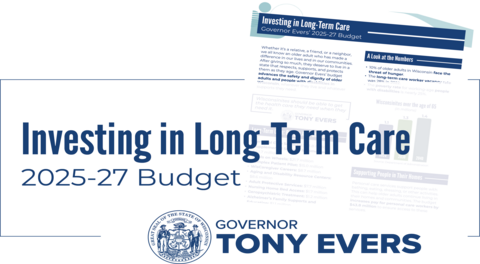Proposed Budget: Investing in Long-Term Care
Whether it's a family member, friend, or neighbor, we all know an older adult who has made a difference in our lives and our communities. After giving so much to Wisconsin, they deserve Wisconsin to respect, support, and protect them as they age.
Gov. Evers’ budget advances the safety and dignity of older adults and people with disabilities and makes significant investments to bolster, stabilize, and support long-term care providers across the state.
It invests in industries to provide meaningful supports throughout all stages of life.
- Continue home- and community-based services. The budget includes $43.8 million to increase rates for medical services provided through personal care programs. Personal care services support people with bathing, eating, dressing, or other activities which can help older adults continue living in their homes and communities.
- Complex Patient Pilot. The governor’s budget invests $15 million into a Complex Patient Pilot which aims to address difficulties and delays experienced in the transition from hospital to other places, such as nursing homes. With the state’s population rapidly aging, investments like this are more critical than ever to ensure Wisconsinites are cared for in the most appropriate setting for their needs.
- Funding the Supplemental Security Income program to help keep seniors out of poverty. The Supplemental Security Income program provides vital payments to older adults and people with disabilities who have little or no income. However, state payments have not changed since 1994. The budget provides a long-overdue $42.7 million boost to payments in this program.
- Meals on Wheels. No senior in Wisconsin should have to worry about where their next meal will come from. The budget provides $21.7 million for home-delivered meals so fewer older adults in our state will struggle with hunger.
- Connecting people to services. ADRCs (aging and disability resource centers) in all 72 Wisconsin counties, along with 10 Tribal aging and disability resource specialists (ADRS) are one-stop shops providing access to services for older adults and those with disabilities, regardless of income. As our state's population ages, the budget provides $8.6 million to keep up with the trend so older Wisconsinites and those with disabilities can live their healthiest and most independent lives.
- Invest in the long-term care workforce. Long-term care workers are critical in providing care to Wisconsin’s most vulnerable residents. At the same time, our state faces a critical shortage of long-term care workers. Gov. Evers’ budget provides $8.7 million for the WisCaregiver Careers program, which supports recruitment, training, and retention of individuals to care for nursing home residents across Wisconsin.
- Expand the Alzheimer’s Family and Caregiver Support Program. The governor’s budget recommends increasing funding for the Alzheimer's Family and Caregiver Support Program, in addition to increasing expenditure authority for the existing Alzheimer’s disease grant.
Other initiatives in the governor's budget to support the long-term care industry
- Wisconsin Assistive Technology Program
- Office for the Deaf and Hard of Hearing Service Fund
- Respite Care Grant
- Grants to Independent Living Centers
- Guardianship Grants
- Falls Prevention
- Office of Plan Review and Inspection Positions
- Bureau of Assisted Living
- CLTS Statutory Language

